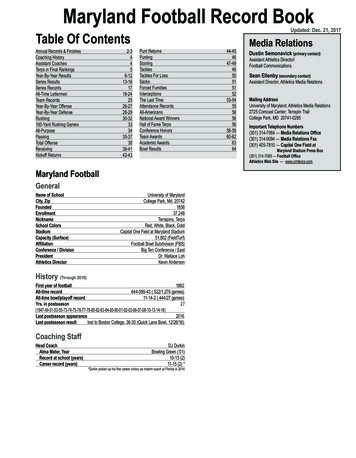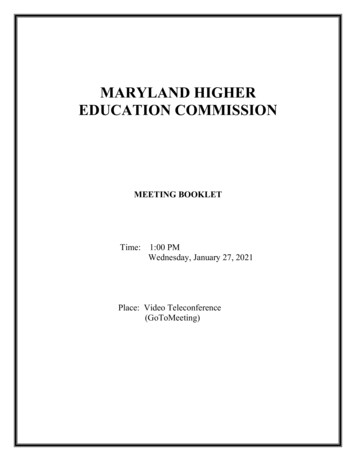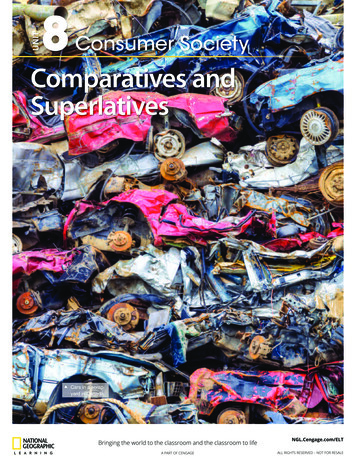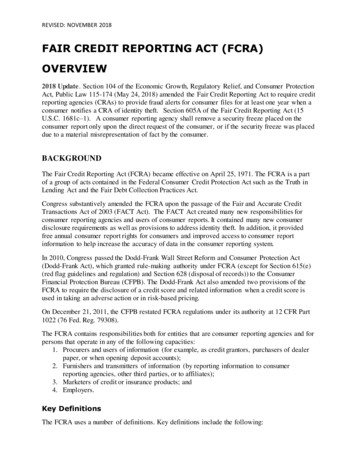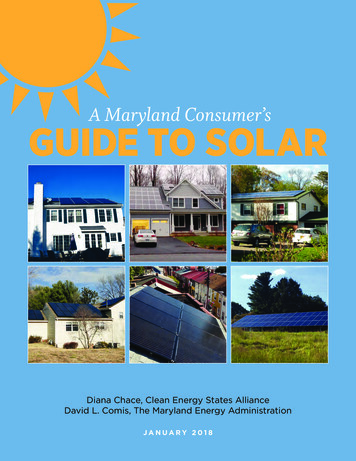
Transcription
A Maryland Consumer’sGuide to SolarDiana Chace, Clean Energy States AllianceDavid L. Comis, The Maryland Energy AdministrationJanuary 2018A maryland consumer’s Guide to Solar1
Prepared for the Maryland Energy Administrationby members of the Maryland Energy Administrationand the Clean Energy States Alliance.About the Maryland EnergyAdministration (MEA)The Maryland Energy Administration (MEA)promotes affordable, reliable and cleaner energyfor the benefit of all Marylanders. To achieve thismission, MEA advises the Governor and GeneralAssembly on matters relating to energy policy.MEA administers grant and loan programs toencourage clean energy technologies in all sectorsof Maryland’s economy: residential, commercial,agricultural, and transportation. To learn more,go to t Clean Energy States AllianceClean Energy States Alliance (CESA) is anational, nonprofit coalition of public agenciesand organizations working together to advanceclean energy. CESA members—mostly stateagencies—include many of the most innovative,successful, and influential public funders ofclean energy initiatives in the country. CESAworks with state leaders, federal agencies,industry representatives, and other stakeholdersto develop and promote clean energy technologiesand markets. It supports effective state and localpolicies, programs, and innovation in the cleanenergy sector, with an emphasis on renewableenergy, power generation, financing strategies,and economic development. CESA facilitatesinformation sharing, provides technical assistance,coordinates multi-state collaborative projects,and communicates the views and achievementsof its members. Learn more at www.cesa.org.Unless otherwise indicated,all photos are courtesy of MDV-SEIA.2T h e Ma r y l a n d E n e r g y a d m i n i s t r a t i o nAcknowledgementsSome of the material used inthis guide was originally writtenby Diana Chace and Clay Mitchellfor A Vermonter’s Guide to ResidentialSolar, a guide funded by the VermontDepartment of Public Service througha grant from the U.S. Departmentof Energy SunShot Initiative RooftopSolar Challenge II. A MarylandConsumer’s Guide to Solar wasproduced and funded by the CleanEnergy States Alliance (CESA)and the Maryland EnergyAdministration.DisclaimersThis report is for informationalpurposes only and does not constitutelegal or financial advice from the U.S.Department of Energy, the MarylandEnergy Administration, CESA, orother contributors.
A Note from the DirectorSo you are considering “going solar?”This booklet is designed to provide an educational resource for Maryland residents who are consideringinstalling a solar photovoltaic system on their home. As solar PV systems are expected to have lifetimesof 25 years or more, it is important for residents to have a good understanding of all aspects of thedecision to “go solar.” Among other things, this guide discusses the attributes of a good residential solarsystem, different methods of system ownership or finance, and key questions to ask BEFORE signing acontract. Many of the topics addressed in this document are based on frequently asked questionsregarding solar submitted to the Maryland Energy Administration, the State of Maryland’s energy office.This solar guidebook also discusses Community Solar, a new pilot program in Maryland that providessolar options for those who rent, as well as for those households who may not have good solar accessdue to shadowing from trees or other buildings.If after reading this booklet you have additional questions, feel free to consult the Maryland EnergyAdministration website (www.energy.maryland.gov) or call 410-537-4000.Mary Beth TungDirectorA maryland consumer’s Guide to Solar3
This page intentionally left blank.4T h e Ma r y l a n d E n e r g y a d m i n i s t r a t i o n
Table of ContentsAbout This Guide. 710 Key Things to Remember if You’re Thinking about Solar. 8Section 1: Reasons Maryland Residents Are Choosing Solar.10Energy Efficiency First.10Financial.10Environmental.10Local Economic Development.10Solar Goals.10Energy Independence and Resilience.10Section 2: What Is a Solar PV System?.12The Solar Cell and Panel.12Materials.13Racking and 7Including Storage—On-grid and Off-grid Options.17Solar Photovoltaics vs. Solar Thermal.17Section 3: Is a PV System Right for You?.18Efficiency.18Renter or Owner.18Electric Bill.18Roofing Material, Roof Age, and Roof Condition.20How Much Direct Sunlight Does Your Roof Get? (Orientation, Tilt, and Shading).21Neighborhood Concerns.21Community Solar (Off-site Solar).21What Happens with Your Solar Panels if You Move to a New Home?.22Online Solar Calculators.23Your Goals.23Section 4: Financing Your Solar PV System.241. Direct Ownership.24Secured vs. Unsecured.24Market Rate vs. Credit Enhanced.242. Third-Party Ownership.24Lease.24Power Purchase Agreements.25Contract Provisions: Leases and Power Purchase Agreements.25Fixture Filings.27Upfront Lease Payment Option.27Sample Language.27A maryland consumer’s Guide to Solar5
Section 5: How You Save Money.28Federal Tax Credit.28Renewable Energy Certificates (RECs).28Net Metering.29Maryland State and Local Property Tax.30Maryland State Incentives.30Section 6: Choosing a Contractor.31Where to Look.31Qualifications.32Where to Check for Complaints.32What Bids Should Include.32Comparing Bids.33Signing a Contract.34Section 7: Permitting and SREC Registration.36Certificate of Public Convenience and Necessity (CPCN).36Interconnection Agreement.36Registering for SRECs.37Section 8: After the System is Installed.38System Maintenance.38Cleaning.38Monitoring Your System.39System Safety.41Insurance.42Warranties.43How to Address a Problem with a Solar Company.44Panel Removal.44Section 9: Questions to Ask a Solar Contractor.45Additional Questions for a System with a Lease or Net Metering Credit Purchase Agreement.45Additional Questions that Only Apply to a Community Solar Subscription.46Section 10: Solar PV Checklist.47Resources.49Official Information on Net Metering and Community Solar in Maryland.49Maryland Organizations.49Other Resources.49Utility Resources.49Glossary.50Appendix A: Calculating Savings from Solar.52Appendix B: Annotated Code of Maryland, Regarding Homeowners Associations.55Appendix C: County Permit Offices.57Appendix D: How to Size a Solar System.646T h e Ma r y l a n d E n e r g y a d m i n i s t r a t i o n
about this GuideIf you’re a Maryland resident considering solar power (alsoknown as photovoltaics or PV), this guide will equip you withinformation you need in order to make sound decisions. Solarpower has many benefits, but investing in it may not be foreveryone. There are many different ways to structure andfinance a solar system. This guide will help you decide ifthere’s an approach that will work for you.This guide is for reference. You do not have to read it fromcover to cover. Some readers will be more interested thanothers in learning the technical details of how panels work,or in learning how to sell Solar Renewable Energy Certificates.You may want to refer to certain sections at different pointsin the decision making and installation process. Understanding all of the factors that describe a solar installation is complicated, but keep in mind that thousands of these systems havebeen installed and most of the project owners are not expertsin physics, economics, or electrical engineering. This guideprovides information in the following sections:S ectio n 1 :Reasons Maryland residents are choosing solarS ectio n 2 :The physical components of a PV systemS ectio n 3 :Consumer needs, opportunities, and systemdesign considerationsS ectio n 4 :Ways to finance a solar systemSolar savings and incentives, including thefederal tax credit, net metering, and RenewableEnergy Certificates (RECs)S ectio n 5 :S ectio n 6 :Choosing a solar contractor and reviewinga solar contractS ectio n 7 :Solar system permittingS ectio n 8 :What happens after your system is installedS ectio n 9 :A list of questions to ask a prospectivesolar contractorS ectio n 1 0 :A checklist for going solarSolar panels are a big investment, whether you buy themoutright, finance them over a number of years, or sign a contract to purchase the power from an array. Take some timeto learn about solar power, and about your contract, so youcan be confident that your investment is a good one.AA mmaarryy ll aanndd ccoonn ss uummeerr ’’ ss GGuu ii ddee ttoo SS oo ll aarr 77
10 Key Thingsto RememberIf You’re Thinking about Solar1. Consider energy efficiency.Consider installing energy efficiency measures first, before you install solar.Reducing the amount of energy used by your home will allow you to installa smaller, less expensive photovoltaic system. See “Energy Efficiency First”on p. 10.2. Solar is a significant investment.Going solar is a significant investment, comparable to buying a car or makingmajor home improvements. Make sure you think it through carefully.3. Financing options are available.There are four main ways to pay for a solar photovoltaic system, each of which hasadvantages and disadvantages. See “Financing Your Solar PV System” on p. 24. Paying cash up front Financing a system through a loan Signing a solar lease Signing a power purchase agreement4. Net metering is key.Net metering is an arrangement in which the utility credits you for electricityyour system generates that is not used onsite and is instead added back onto thegrid. See “Net Metering” on p. 29.8T h e Ma r y l a n d E n e r g y a d m i n i s t r a t i o n
5. Community solar is an option.If installing solar on your own home or land isn’t viable, or if you don’t ownyour home, there are still solar options for you. Both renters and homeownerscan potentially participate in a community solar project, which is an offsitesolar array that serves multiple customers. See “Community Solar” on p. 21.6. Federal incentives are available.For those solar photovoltaic system owners that pay federal income taxes,the federal government provides a significant tax credit that helps reduce thetotal cost of your solar system. See “Federal Tax Credit” on p. 28.7. Several contractor bids are better than one.Consider proposals or bids from at least three different solar contractors to helpselect the best solar installer for you. See “Choosing a Contractor” on p. 31.8. Calculate the financial deal.Before selecting a bid and signing a solar contract, calculate your net savings,return on investment, and/or payback period. See “Calculating Savings” on p. 52.9. Understand the impact of changing utility rates.In any calculation of how much money your solar system can save you,assumptions about future utility rate increases are very important. Make surethat you and your contractor are calculating future electricity costs appropriately.See “Understanding Utility Rate Increase Impacts” on p. 33.10. Know what you are signing.Make sure you read and understand your solar contract before you sign it.See “Contract Provisions” on p. 25 as well as “Signing a Contract” on p. 34.A maryland consumer’s Guide to Solar9
Section 1Reasons Maryland Residents Are Choosing SolarEnergy Efficiency FirstEnergy efficiency should always comefirst. It is usually more cost efficientthan solar; it reduces the cost, size andfootprint of the final solar system; andit is often subsidized by the local utilityunder the EmPower Maryland program.Installing insulation in the attic andwalls, adding weather-stripping, usingenergy efficient lights (such as LEDlighting), and using energy efficientappliances (such as those identifiedas EnergyStar ) can provide energysavings month after month while alsoreducing the size of the desired solarsystem. Every home is different, sohomeowners should have a completehome energy audit conducted to guidethe energy efficiency effort. The sizeof a solar system is often based on theThere are a variety of reasons to choose solar. Below, we list someof the most common:FinancialAs the cost of solar panels has fallen significantly over the pastdecade, many Maryland residents have been able to save moneywith solar panels.EnvironmentalMuch of the electricity used in Maryland comes from power plantsthat burn fossil fuels.1 When fossil fuels are burned, they produceemissions that contribute to air pollution, as well as producing carbondioxide, a greenhouse gas which causes global warming. Solar panelscan reduce the need for electricity production from fossils fuels andthereby decrease the emission of greenhouse gasses.Local Economic DevelopmentSolar installations in Maryland give rise to in-state solar constructionand maintenance jobs. According to the Solar Foundation 2016 SolarJobs Census, Maryland employed over 5,429 people in jobs directlyrelated to the project development, manufacturing, installation andsales of solar energy systems. This was a 27 percent increase overthe 2015 Solar Job Census.2total amount of electricity used in ayear; for the most accurate results, theenergy impacts of efficiency measuresshould ideally be tracked for a yearto determine the correct new baselinefor solar array sizing. Alternatively, thenew energy baseline can be estimatedgiven the old baseline and the estimateof energy savings from the energyefficiency measures.12310Solar GoalsThe Maryland Renewable Portfolio Standard (RPS) sets requirements for the renewable energy attributes of the state’s electricity. Inaddition to a general renewable energy requirement, the RPS includesa specific amount of electricity which must come from solar energy(commonly called the solar carve-out).3Energy Independence and ResilienceSome Maryland residents choose solar because they want to be moreindependent and produce their own power, or because they are farWhile only about 40 percent of the electricity produced in Maryland comes from fossil fuels, Maryland imports electricity from surroundingstates which tend to be more dependent on fossil fuels. Electricity generated in Maryland (and producing pollution in Maryland) includes:nuclear 45.5%, coal 25.4%, natural gas 16.3%, hydroelectric 8.3%, non-hydroelectric renewables 4.0%, and petroleum fired generators 0.4%.U.S. Energy Information Administration webpage. Maryland State Profile and Energy Estimates, accessed 8/31/2017 https://www.eia.gov/state/?sid MD#tabs-4The Solar Foundation webpage. Solar Jobs Census 2016. Accessed 8/31/2017 otated Code of Maryland: Public Utilities, Section 7–703.T h e Ma r y l a n d E n e r g y a d m i n i s t r a t i o n
from the power grid. Residential solar systems can be either off-grid (not connected to the electricgrid) or grid-connected. To be completely independent of the grid requires investing in a standalone inverter system and installing battery storage. Most people who go solar don’t choose anoff-grid system. A grid-connected PV system will not function in the case of an electricity outageunless the home has an accompanying electricity storage system and the ability to “island”(completely disconnect from the grid). But even a simple grid-connected system provides somecost independence as it reduces the amount of electricity purchased from the grid and thereforesubject to utility rate fluctuations. CESA/Blais CostelloAs the cost of solar panels has fallen significantly over thepast decade, many Maryland residents have been able to savemoney with solar panels.A maryland consumer’s Guide to Solar11
Section 2What Is a Solar PV System?Photovoltaic (PV) systems convert sunlight into electricity. Sunlight strikes the solar panelmaterial and frees electrons, creating electricity.The electricity produced in a photovoltaic system is direct current (DC). Other than someoff-grid homes and specialized appliances, homes use alternating current (AC). The PV systemchanges the DC into AC through the use of an inverter. The output of the inverter is thenconnected to the home’s electrical system so that the electricity produced by the PV systemcan power the home.PV systems have few moving parts and are generally very reliable. They require littlemaintenance. Understanding the components of a PV system can help you decide whetherto go solar, and how.The Solar Cell and PanelThe basic electricity producing structure is the solar cell, which is normally comprised of siliconand electrodes. Cells are strung together in a module (often called a panel). A number of panelsconnected together electrically (in series) and fed into the inverter (described below) is knownas a string. The entire system, consisting of one or more strings connected together in parallel,is referred to as the solar array.F ig u r e 1Typical Component PlacementMeterMeterSource: LetsGoSolar.com12T h e Ma r y l a n d E n e r g y a d m i n i s t r a t i o n
F ig u r e 2Traditional Rooftop Mounting SystemSource: LetsGoSolar.comThe output of a panel is measured in DC-watts.4 The nameplate output of a panel representsthe amount of power produced under rated conditions. Lower output panels have fewer cells andcome in smaller sizes. Choice of panel size, output and shape will usually depend on the installationmethod and location. Solar panels are available in varying colors, shapes, power outputs,efficiency and appearance.5MaterialsThe external components of a solar panel include the cover (usually glass with an anti-reflectivecoating), composite backing, aluminum frame along the perimeter and sometimes along the back,and wiring to connect the panel to the rest of the system. A back frame, when present, helps tosupport the weight of the panel under snow loads.Inside the panels, different kinds of cell materials are used to generate electricity. Currently, themost widely used material is a polycrystalline silicon, which is inexpensive to manufacture and canbe recognized by subtle shades of blue and blue-black in the cells. Another, more expensive optionis to use monocrystalline silicon, which uses purer silicon grown into a single crystal structure.This material results in a uniform color and slightly increased output efficiency. Another optionis thin film manufactured cells, which are less expensive to manufacture but are also less efficient.This material is used in a wide range of installations, including flexible panels and roofingmaterials.Building-integrated panels (BIP) refer to solar panels that replace the need for conventionalwa
Going solar is a significant investment, comparable to buying a car or making major home improvements. Make sure you think it through carefully. 3. Financing options are available. e are four main ways to pay for a solar photovoltaic system, each of which has Ther advantages and disadvantages. See "Financing Your Solar PV System" on p. 24.
